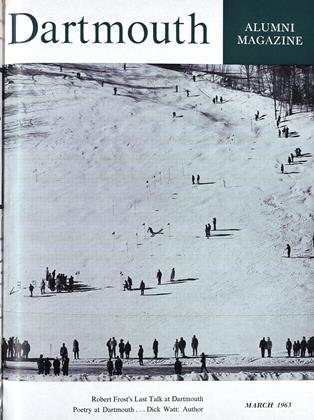By Edward P. Stafford '42. NewYork: Random House, 1962. 499 pp.$7.95.
This is a salty, seagoing, adventure story from beginning to end - a fascinating, exciting, and moving war story. It is the tale of a brave and sturdy warship, a floating airfield, Enterprise, which fought through four years of World War II and achieved a combat record second to none, probably in all history.
The Big E is the biography of a carrier, but it also tells, for the first time, the part played by courageous men who fought her both on board and in the air. Dartmouth men, particularly, will be interested and proud to know that Lieutenant (j.g.) Charles M. "Stubby" Pearson '42 was one who served her gallantly. He met a tragic death, finally, in a dive-bombing action at Palau.
When World War II broke, Enterprise was Vice Admiral William F. Halsey's flagship. However, on November 28, 1941, nine days before Pearl Harbor, while heading for Wake, the Admiral placed the carrier on a war basis. Guns were ordered manned and in continuous readiness; regular searches were inaugurated. Furthermore, the Admiral directed that any Japanese or unidentified ship or aircraft approaching his task force was to be destroyed. When the staff operations officer read the order, he bolted to the Admiral's cabin with, "Do you realize that this means war?" He received a blunt, "Yes." The officer tried again, "Now, goddammit, Admiral, you can't start a private war of your own! Who's going to take the responsibility?" Snapped the Admiral, "I'll take it!" The tone had been set and Big E was at war. Such was characteristic of "Bull" Halsey and of his well-ordered, taut, alert carrier.
She had already earned a reputation as a tough, competent, happy ship. Big E was her nickname, of course. The "E" stood for Enterprise and excellence. Her proud crew identified her with the coveted Efficiency award for which all ships of the fleet annually compete.
During the four long years of war, she shared in practically every major Pacific battle — twenty out of a possible twenty-two set her unique record. Her battle stars cover the wide Pacific - Midway, Guadalcanal, Santa Cruz, Kwajalein, Philippine Sea, Leyte Gulf, Iwo Jima, Okinawa, and many more. Secretary of the Navy Forrestal said the Enterprise was "the one ship" that most nearly symbolized "the history of the Navy in this war."
She was officially credited with downing 911 enemy planes, sinking 71 ships, and damaging almost 200 others before receiving a knockout blow by a kamikaze.
The Japanese had proudly announced on no less than seven occasions that they had sunk Enterprise, but they were wrong. Although badly battered, she miraculously escaped destruction so often, she became known in the fleet as the "Galloping Ghost."
An impressive amount of research has gone into this well-written book. The author, Commander Edward P. Stafford, an aviator in the regular Navy, utilized official records, private diaries, hundreds of questionnaires, and countless interviews. So closely has the author identified himself with the story he tells that it is difficult to believe that he did not experience, on board Enterprise, the events he recounts so graphically.
A satisfactory battle map and more than 30 official photographs help to tell the story. The account of The Big E needed to be told. It will not only entertain but also inspire and deeply move those who read it.
 View Full Issue
View Full Issue
More From This Issue
-
 Feature
FeaturePOETRY AT DARTMOUTH
March 1963 By RICHARD EBERHART '26 -
 Feature
FeatureRobert Frost on "Extravagance"
March 1963 -
 Feature
FeatureTHE SECRET LIFE OF RICHARD WATT
March 1963 By DON MURRAY -
 Class Notes
Class Notes1921
March 1963 By JOHN HURD, HUGH M. MCKAY -
 Article
ArticleScholarly Stimulator of Comparative Study
March 1963 By G.O'C. -
 Class Notes
Class Notes1920
March 1963 By CHARLES F. MCGOUGHRAN, ALBERT W. FREY
Books
-
 Books
BooksTHE FAR AND THE DEEP.
MARCH 1968 By CAPT. L.S. SMITH JR., USN -
 Books
BooksALL THE BEST IN BELGIUM AND LUXEMBOURG.
May 1956 By DONALD L. STONE -
 Books
BooksDOCTOR DESTINY
June 1947 By John F. Gile '16 -
 Books
BooksValedictory
DECEMBER 1981 By Robert H. Ross '38 -
 Books
BooksAMERICAN SHIPS.
FEBRUARY 1972 By STEPHEN G. NICHOLS JR. '58 -
 Books
Books"SPEAK THAT I MAY SEE THEE!": THE RELIGIOUS SIGNIFICANCE OF LANGUAGE.
OCTOBER 1968 By T.S.K. SCOTT-CRAIG

